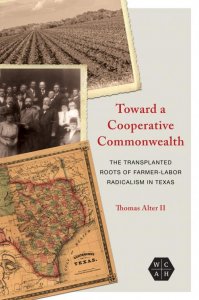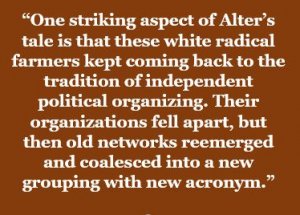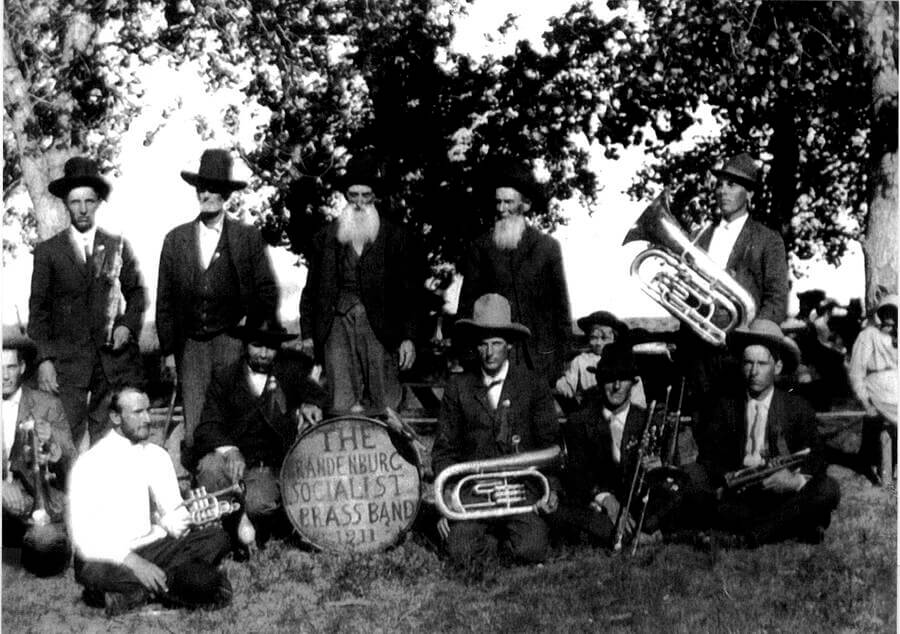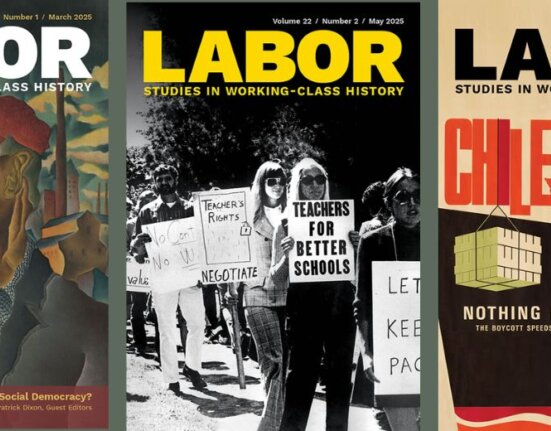This essay is the second contribution to our symposium on Tom Alter’s new book, Toward a Cooperative Commonwealth: The Transplanted Roots of Farmer-Labor Radicalism in Texas, published recently by University of Illinois Press. We started with Kyle Wilkison’s analysis of the book’s contribution and survey of previous literature. Today Theresa Case weighs in with a tour of the book and some questions. Next up will be Chad Pearson as well as a response by Tom Alter. Thanks to Chad Pearson for organizing this symposium. These are peer-reviewed.

Tom Alter’s book, Toward a Cooperative Commonwealth, gives us an ambitious, provocative new history of farmer/labor radicalism in Texas. The story he tells is a transnational one in which German immigrants figure prominently, especially the menfolk of the Meitzen family. The Meitzens and their associates, who organized and led radical economic movements were not, as one might think, romantics or ideologues who from time to time made noise on the margins of Texas political history. Instead, in Alter’s rendering, they were pragmatic rather than rigid in their thinking; they were responsive and attentive to their mostly white constituency; and, from the margins, they reconfigured the political landscape. They pushed the Democratic Party to back meaningful reforms and laid the groundwork for the New Deal. However, Alter does not celebrate these Texas radicals’ embrace of FDR; instead, his contention is that Texas movements for economic justice historically have done best when they have waged campaigns independent of the two major parties. In addition, he argues, they would have done better to broaden their scope and appeal across lines of race and ethnicity.
To help set the stage for our conversation about the book, my comments will take you all on a tour of its principal features.
First, Dr. Alter’s achievement in researching so thoroughly the roots and reach of these radical movements deserves recognition and admiration. He mined archives from cities across the map of Texas to Michigan, North Dakota, Indiana, Minnesota, Florida, Illinois, Berlin, and Poland. His footnotes include citations from over forty Texas newspapers, and from at least a dozen additional US states as well as from Prussia, and numerous socialist and labor publications. This is quite a feat.
One reason many of his sources come from across the US and across the Atlantic is because Texas economic radicals joined national organizations such as the People’s and the Socialist Parties, and they cooperated with those of like mind in the Midwest. Additionally, as Alter shows, one big spark that instigated independent working-class organization in Texas began in Prussia, specifically, a region called Silesia, one of many regions in which the 1848 Revolution unfolded.
Alter contends that the 1848 revolution was not simply a rebellion by middle-class intellectuals. Working-class protests were integral to that upheaval, and Silesia was unique in an important respect: it boasted a strong alliance of farmers and workers. The area had seen a series of peasant-worker revolts as feudal lords shifted from a system of brutal agrarian exploitation to brutal industrial exploitation, principally in textile mills. Otto Meitzen and his brother William were part of the emerging middle class in Silesia; Otto likely joined the Democratic Club in the city of Liegnitz, which was a major hotbed of unrest where middle class activists such as the Meitzens worked closely with workers and peasants and engaged in militant protests. A close family member published a radical newspaper in Liegitz, led the city’s democratic club, and helped build the peasant-worker alliance there.
The counterrevolution against 1848 crushed the protests and threatened activists with imprisonment or execution. Like thousands of other participants in the Revolution, Otto Meitzen and his family fled the repression and settled in Central Texas in 1850. In Texas, the Meitzens were tenant farmers for a time and saw the damage done by falling cotton prices, rising debt to landlords, and an exploding permanent waged labor force. In short, the Meitzens witnessed some of the same economic conditions in Texas that they had rebelled against in Germany.
In Texas, the Meitzens found themselves without a political home to address these concerns. The Democratic Party was the party of slavery and secession while most German immigrants were anti-slavery, and many were either Unionists or reluctant, even involuntary, Confederates, i.e., they were draftees, not volunteers. The Republican Party initially beckoned after the Civil War because of German immigrants’ general opposition to slavery and secession. A significant number of German immigrants formed alliances with other Texas immigrants and with black Texans, but the Republican Party proved inhospitable due to its nativist influence, and, like the Democrat leadership, Republican leadership courted the powerful and disregarded the rising numbers trapped in tenancy and sharecropping.
The Meitzens and other German inheritors of the 1848 revolution ultimately carved out their own space in a series of radical movements. Though at different intervals, they backed apolitical efforts, cross-class organizing, and movements to establish cooperatives, they always wound up in the camp that advocated for independent parties and organizations in which industrial workers and farmers found common cause against an American oligarchy. That became their political home.

E. O. Meitzen, “Red” Tom Hickey, and the Boeer family, owned the Rebel, which was a socialist paper out of Hallettsville, published between 1911 and 1917. E. O.’s son, E. R. Meitzen, helped to run the paper. This father-son political partnership stretched back for decades prior to the Rebel, and it is that activism that Alter’s study highlights, although other Meitzens were also in the picture. E.O’s father was Otto, who had emigrated from Silesia and raised his family on the ideals of the 1848 revolution. E. O., and E. R. in turn, infused these ideals into their activism as they joined and led a slew of farmer organizations between the 1870s and the 1920s, such as the Grange, the Greenback Labor Party, the Farmers’ Alliance, the People’s Party, the Socialist Party, and the Farmers’ Union.
Alter writes that the Meitzen’s instincts were democratic and attuned to the aspirations and grievances of landless farmers and waged laborers. They fought the reigning Socialist Party assumption that farmers were bourgeois. They saw farmers as part of the working class; at the same time, they rejected the far-left wing socialist call to collectivize agriculture, a demand they knew would not resonate with Texas farmers and that violated their belief that a private family farm was not exploitative. Beyond their deep identification with farmers, the Meitzens inherited the “revolutionary zeal” of their immigrant relations. To their minds, gradual, piecemeal reform was good if that was all one could achieve, but the Meitzens consistently aimed higher and strove to realize their ultimate vision of a cooperative commonwealth. Alter describes this socialist vision as at base a moral one. It condemned capitalist control of land, resources, and production. They championed nationalization of basic industries, land for those who tilled it and, to industrial workers, the fruits of their labor.
What place did black and Mexican farmers have in the cooperative commonwealth? Alter describes how, in the 1880s and into the 1890s, Texas populists engaged in cross racial organizing based on shared economic grievances. To weaken the force of the Democrats’ race-baiting, populists steered clear of anything that smacked of social equality. To some extent, populists were able to fuse with the radical, pro-black rights wing of the Republican Party. Although most black voters remained in the Republican Party, those radical interracial alliances were strong enough and significant enough that, once the People’s Party disintegrated in the wake of their 1896 defeat, the Democratic Party took every measure they could to doom future cross racial initiatives. The poll tax and the white primary undermined black voting rights in Texas (and the voting rights of many poor whites).
Once the Jim Crow regime was further cemented in place, the Meitzens and other white radicals generally made few gestures to black farmers. In contrast to the populists’ earlier broad economic appeals, the socialist Rebel was often explicitly hostile to non-whites and concerned instead with the plight of white farmers alone, often casting white renters as the victims of their Mexican and black competitors. Although the Meitzens steered clear of Klan membership in the 1920s, in 1922 the Klan candidate for US Senate, Earle Mayfield, very likely drew substantial support from white working-class voters.
Alter discovers that, while white radicals turned away from black farmers and laborers in the early twentieth century, the Mexican Revolution tempered their racial beliefs regarding ethnic Mexicans. The courage and tenacity of landless Mexicans who championed “land and liberty” on both sides of the border impressed white Texas socialists. The Rebel changed its tone to one of respect, the socialist-organized Renter’s Union opened to non-whites, and Mexican American organizers such as F. A. Fernandez brought hundreds of Mexican renters into the socialist fold. The Socialist Party continued its opposition to US military intervention in Mexico and raised money to bail out Hernandez when he was arrested for socialist speechmaking, even in the repressive and fearful atmosphere surrounding the Plan de San Diego.
 One striking aspect of Alter’s tale is that these white radical farmers kept coming back to the tradition of independent political organizing. Their organizations fell apart, but then old networks reemerged and coalesced into a new grouping with new acronym. Partly, this constancy was rooted in the worsening conditions that confronted farmers. Partly, they were moved by examples of state violence against the efforts of fellow producers to protect themselves against unchecked capitalism – during the Southwest Strike, the Galveston longshoremen’s strike, and the Pullman strike.
One striking aspect of Alter’s tale is that these white radical farmers kept coming back to the tradition of independent political organizing. Their organizations fell apart, but then old networks reemerged and coalesced into a new grouping with new acronym. Partly, this constancy was rooted in the worsening conditions that confronted farmers. Partly, they were moved by examples of state violence against the efforts of fellow producers to protect themselves against unchecked capitalism – during the Southwest Strike, the Galveston longshoremen’s strike, and the Pullman strike.
Another reason why these movements resurrected themselves was because earlier formulations had built a movement culture that attracted thousands to summer encampments and to mass meetings galvanized to action by fiery speakers. The Texas leadership’s emphasis on local control and rank-and-file democracy strengthened this movement culture. Finally, when the chips were down, Meitzen and others were willing to hitch a ride on the coattails of whatever farmers’ organization was rising at the moment, so when, for example, the wartime Red Scare took a severe toll on the ranks of the Socialist Party, Meitzen and other leaders sought to reinvigorate the Party by working with the Non Partisan League, which had elected a sizeable contingent to offices in North Dakota.
Texas farmer-labor organizations had periods in which the overriding sentiment encouraged members to either work within the Democratic Party or renounce politics and remain apolitical. That was the case with the Farmers’ Alliance and later the Farmers’ Union. But, Alter argues, farmer/labor movements achieved more when they relied on independent political parties to push the two-party system to move to the left. Without this outsider pressure, Alter claims, Texas “might never have left the Gilded Age (11).”
The examples of the Greenback Labor Party and the People’s Party illustrate Alter’s thesis. These parties’ cross racial appeal and support held real potential for electoral success. The Democratic Party’s fear of populist influence was enough to drive the Party leftward, so that the Democratic governor James Hogg got behind at least some of the reforms pushed by the independents. It is true that Hogg rejected the sub-treasury plan, a more radical demand, yet his 1892 platform advocated the populist calls for free silver, a graduated income tax, and a state railroad commission, and in 1906 the Democratic Party platform promised to root out monopoly. In 1914, the Socialist Party made land the most talked about subject of the election, and Meitzen brought national attention to the plight of Texas agricultural workers in his testimony before the Walsh Commission. Farmer/labor condemnations of unbridled corporate power and concentrated wealth no longer existed on the margins of political discourse. By the 1930s, they became central concerns of New Deal programs and to FDR’s election strategy.
I will end my tour there and put a few questions on the table for Dr. Alter:
- You suggest that, at one point, had white radicals made stronger common cause with black and brown radicals, they might have won electorally, but would the Democrats have allowed them to take power? The federal government probably would not have intervened. Where do you think such a victory likely would have led?
- You do not talk much about the urban/rural divide because race was the main divider. Is there anything that did not make it into the book, or that I’m overlooking that gives us some insights into the relationship between industrial workers and landless farmers in Texas? For example, did industrial workers tend to have some farming in their background/family that meant they had a natural affinity for farmers? Although farmers aided and sympathized with different strikes, and farmers and workers cooperated and combined organizationally, did you find a significant element of farmers who looked with disdain on industrial workers (as failures, trash, ignoble, rootless, etc.)? In other words, what big humps did farmers and workers get over to work with each other?
- In the People’s Revolt, Greg Cantrell sees the New Deal reforms as a triumph of Populism. You title your chapter on this subject “Descent into New Deal Liberalism” because many former agrarian radicals wind up working with the Democratic Party. During the 30s, what do you think was possible had these radicals continued to organize independent of the two main parties?
- “Red Tom” Hickey comes off in your book as not a bad sort, in contrast to Neil Foley’s damning portrait of him in The White Scourge. How should we remember Hickey, and since the Meitzens were such close political allies of Hickey, the Meitzens?







